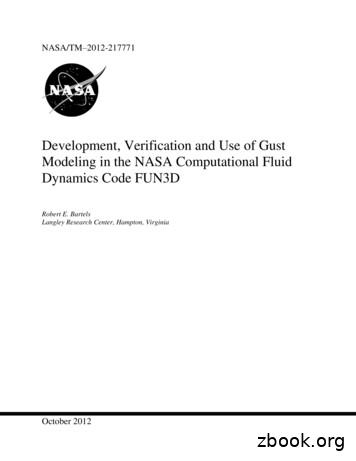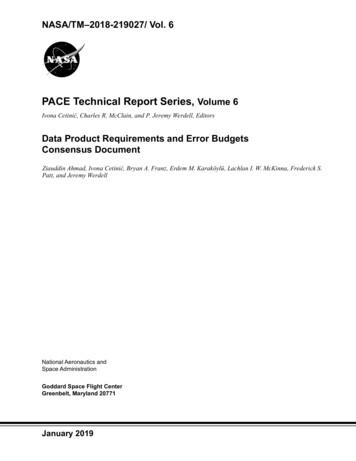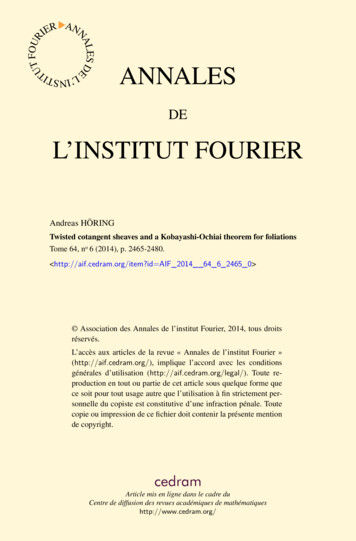Toshimichi Otsubo Mihoko Kobayashi - NASA
Since 1998Toshimichi OtsuboMihoko KobayashiHitotsubashi UniversityTadahiro GotohToshihiro Kubo-okaNational Institute of Information andCommunications Technology116th International Workshop on Laser Ranging, Poznan, 13-17 Oct,
URL: ick2
Range bias & time bias# 7811 BOROWIEC# sat site datetime durJAS2 7811 2008/09/13 00:35 1LAG1 7811 2008/09/13 02:17 15rb mm errortb us error prec bad tot6 ( 7 ) -------.- ( --.- ) 2 0 / 4-1 ( 11 )-24.6 ( 13.1 ) 16 0 / 9See the past proceedings papers on the analysis itself.3
16 satellites being analisedSatellite pictures: ILRS Web4
Why Multi-Satellite?Low and High Satellites– (LAGEOS -1, -2 ) Ajisai, Starlette, Stella, JASON-1, -2,ERS-2, ENVISAT, ETALON-1, -2, GPS & GLONASS(some of them sometimes dropped from the report because of a lack ofobservations, a bad fit of orbit, etc.)– Make problems easily identified.LAGEOS observations NOT required.Time span of the problematic passes clearly seen.Frequency bias detectable.LEO-only or HEO-only problems detectable.– Are not precisely determined compared to LAGEOS, but stilluseful for QC.Do not judge from just one pass.5
Daily Schedule for QC Analysis Automated Daily Procedure– Midnight, JST: Data download from CDDIS, EDC andUSNO. File format arrangement, etc.– 6.30 am JST: Orbit determination (and orbit generationfor tomorrow’s analysis).– 9 to 10 am JST ( 0 to 1h UT): Pass-by-pass residualanalysis.– Upload the report card.– Update the webpage.– Checked by humans(not everyday).6
When we find large biases Human Check : Is the bias large enough? Is it surely ‘their’ problem? Is the problem continuous, not a one-pass event? Has the problem already been solved?SLR Station Who is a contact point of the station?Then,ilamEHello ABC station,It seems your laser observations (Glad if you give me a reply!)SinceOct LE-ma ast Yearil(copy)Hitotsubashi UnivILRS Task Force[1]7
Obvious biases reported to stations: 2008[Sep, 2008] 1 or 2 or 3 RB laser multipulse[Sep, 2008] 2 m RB calibration (human) error.[Jul, 2008] 1.2 km RB calibration error. System testing.[Jul, 2008] 200 ms TB ?.[Jun-Jul, 2008] 132 m RB ?.[Jun, 2008] -20 ms TB hardware & software problem.[Jun, 2008] 10 ms TB software (?)[Apr, 2008] Non-existing station ID human error.[Feb, 2008] Atm pressure error wire problem.[Feb, 2008] 0.5 to 1.7 km RB (Freq bias?) ?[Jan-Feb, 2008] 1 day TB (Wrong Day) ?Quickfeedback[Jan, 2008] 3 m RB laser multipulse. Shortening[Jan, 2008] 18.6 ms TB event timer.error periods.8[Jan, 2008] 2 m TB (LEO Only) ?
DIY for sub-cm accuracyQC at Station(NP generation stage)Pass‐by‐pass QCfrom ACs/AACsLong‐term sub‐cm QCthrough CollaborationWorry about cm or sub-cm systematic error?– ACs do not know what your error source would be.Observer, Time since System Activation, Room Temperature,Signal Intensity, Optical Configuration, and much more!!9
DIY: An Example10-Hz vs 2-kHz at Herstmonceux– SCI 6: 10( ) Hz– SCI 7: 2 kHz Extract “Range bias” from dailyreports (easy spreadsheet job)10
Summary & Future worksAlmost 10 Years’ Continuous Run! CRL NICT HIT-U– Powerful tool for detecting various type of problems.– Many thanks to regular/occasional worldwide users!Communications between stations and ACs– Some E-mail address on ILRS Webpages was obsolete.– Face-to-face workshop is important (thanks Stanislaw!).Future works– Better TRF (SLRF2008? Our own updates?)– Shorter delay (24 hrs to a few hrs?).Want to delete data? Yes, you can, with CRD.– Some cases (wrong day, wrong station ID, etc) are NOTcorrectable/recoverable with the current framework.– CRD: Set “Data Quality Alert Indicator” “2”.11
Leap Second on 1 Jan 2009 !!Last time: 1 Jan 2006Stations– Perfect job last time!– 1 or 2 second time bias (even 1-day, 1-year time bias)seen in the past.– Check the procedure after you go back home.(ACs)– Check the software. Handling of UT1-UTC is tricky.12
Hitotsubashi University Tadahiro Gotoh Toshihiro Kubo-oka National Institute of Information and Communications Technology 16th International Workshop on Laser Ranging, Poznan, 13-17 Oct, 2008. Since 1998
(1991), Peking Man (1997), Blind Beast vs Dwarf (2001), Graveyard of Honor (2002), The Cat Returns (2002), Violent Fire (2002), The Twilight Samurai (2002), and Doomsday: The Sinking of Japan (2006). Andrea Grunert: “Kobayashi, Masaki” (Senses of Cinema) Masaki Kobayashi’s career coincides with the so-called Golden Age of Japanese cinema .
2016 nasa 0 29 nasa-std-8739.4 rev a cha workmanship standard for crimping, interconnecting cables, harnesses, and wiring 2016 nasa 0 30 nasa-hdbk-4008 w/chg 1 programmable logic devices (pld) handbook 2016 nasa 0 31 nasa-std-6016 rev a standard materials and processes requirements for spacecraft 2016 nasa 0 32
Jan 10, 2012 · The NASA STI program provides access to the NASA Aeronautics and Space Database and its public interface, the NASA Technical Report Server, thus providing one of the largest collections of aeronautical and space science STI in the world. Results are published in both non-NASA channels and by NASA in the NASA
The NASA STI program provides access to the NASA Aeronautics and Space Database and its public interface, the NASA Technical Report Server, thus providing one of the largest collections of aero-nautical and space science STI in the world. Results are published in both non-NASA channels and by NASA in the NASA
The NASA STI program provides access to the NASA Aeronautics and Space Database and its public interface, the NASA Technical Report Server, thus providing one of the largest collections of aero-nautical and space science STI in the world. Results are published in both non-NASA channels and by NASA in the NASA STI Report Series, which includes
The NASA STI program provides access to the NASA Aeronautics and Space Database and its public interface, the NASA Technical Report Server, thus providing one of the largest collections of aero-nautical and space science STI in the world. Results are published in both non-NASA channels and by NASA in the NASA STI Report Series, which includes
Ann. Inst. Fourier,Grenoble 64,6(2014)2465-2480 TWISTED COTANGENT SHEAVES AND A KOBAYASHI-OCHIAI THEOREM FOR FOLIATIONS by Andreas HÖRING Abstract.— Let X be a normal projective variety, and let A be an ample CartierdivisoronX.SupposethatX isno
In astrophysics, we use ideas from the various parts of physics - electromagnetism, gravitation, theory of matter, mechanics, quantum theory - to explain what we can see. It’s like being a detective. There is what we observe (the evidence) and there is piecing it together (the thinking). The first year, and a major part of the second year, cover skills and the fundamental principles. The .























